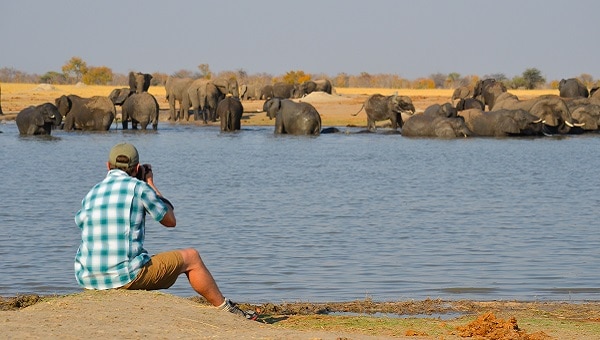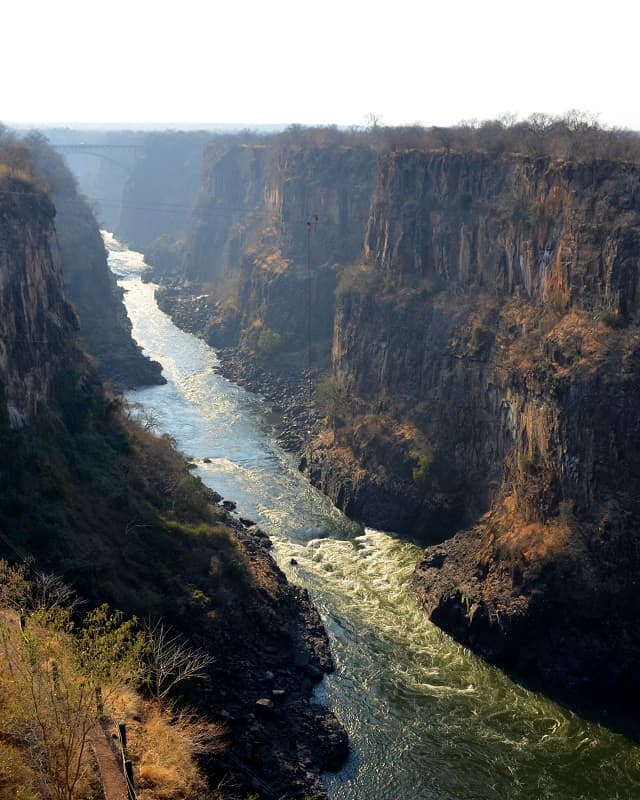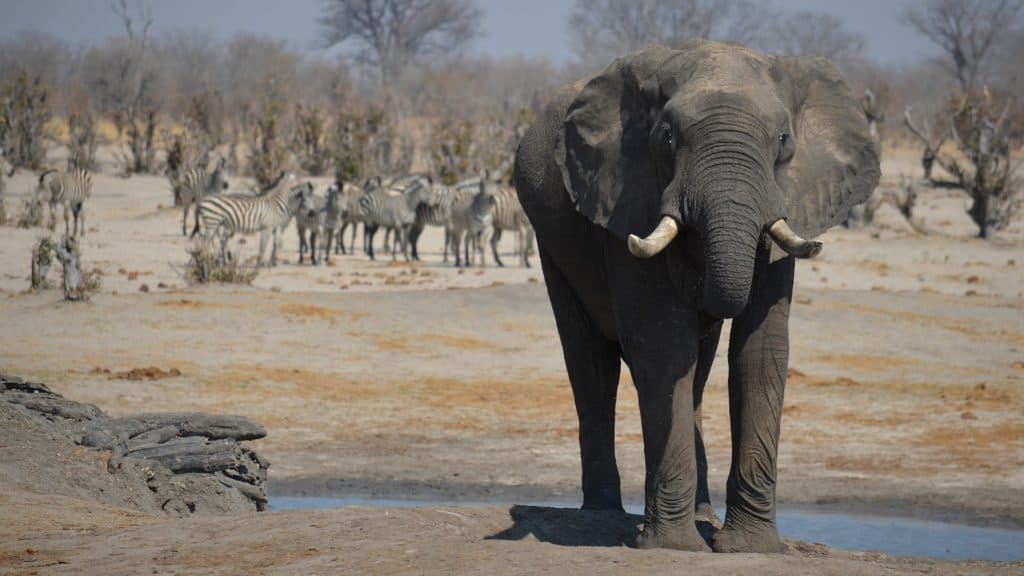Zimbabwe
Gold Standard Guiding
and 'The Smoke That Thunders'
The name “Zimbabwe” comes from the local Shona language meaning, “a great house of stone.” It is best known as the home of Victoria Falls, which remains its biggest attraction. Many safari goers to Botswana and/or South Africa add on Victoria Falls but do nothing else within Zimbabwe. However, true safari insiders know that Zimbabwe is legendary for its guides. Zimbabwe has the most stringent guide exams, many of which are focused on walking, and that has produced a rich legacy of guide quality.
Unfortunately, Zimbabwe tourism has suffered greatly under the reign of the Robert Mugabe regime. However, as the years have passed, safari tourism has begun to rebound. Zimbabwe offers a supreme experience for travelers with a high adventure quotient. Many safaris focus on tracking wildlife on foot, especially in Mana Pools National Park, where you can also add adrenaline with a thrilling canoe trip on the Zambezi River. The fabled Hwange National Park is known for pumped water holes in a dry environment that attract enormous quantities of elephants and buffalo.
Zimbabwe offers great value. Despite the high level of guiding, Zimbabwe is trying to rebuild its tourism sector, making costs often considerably less than similar quality safaris in neighboring Zambia or Botswana. It is also growing in popularity as more safari travelers are looking for more activity and diversity on safari. Zimbabwe excels in that area with many opportunities for walking, canoeing, and boating – even mountain biking is being introduced.


Zimbabwe Sample Safaris
Classic Zimbabwe: Hwange and Mana Pools with Victoria Falls
This adventure-level safari features classic bush camps, thrilling walking safaris, and an excellent value.
Top Zimbabwe Safari Locations
Zimbabwe Safari Regions

Victoria Falls
Overview
Victoria Falls, spanning the border of Zimbabwe and Zambia, is the world’s largest waterfall by volume. Many visitors to Zimbabwe come to see this UNESCO World Heritage site, known locally as “The Smoke That Thunders.”
The Falls are approximately 5,600 feet (1,700 m) wide and 355 feet (108 m) tall. There are five separate waterfalls (Devil’s Cataract, Main Falls, Horseshoe Falls, Rainbow Falls, and Eastern Cataract), over which 150 million gallons of water flow per minute during peak water levels around mid-April. The spray from this water crashing to the canyon floor below can rise up to 1,650 feet high, and visitors during peak water often come out soaked from viewing the falls on foot.
Victoria Falls is also well-known as an adventure destination, with opportunities for visitors to go Class IV and V whitewater rafting in the gorge, bungee jump off the Victoria Falls Bridge, view the Falls from above by helicopter, and many more adrenaline-pumping options.
Location
The Victoria Falls region spans the border of Zimbabwe and Zambia. The town of Victoria Falls, and its Zambian sister town of Livingstone, both provide access to the Falls themselves. The Falls and the Zambezi River form a natural border between the countries.
Access is by international commercial flight to Victoria Falls International Airport (VFA) or Livingstone International Airport (LVI). Many flights connect through other major African cities such as Nairobi, Addis Ababa, and Johannesburg. Victoria Falls can also be reached by road transfer across the border from Kasane, Botswana at the Kazungula border post. Visitors can walk across the famed Victoria Falls Bridge between Victoria Falls and Livingstone.
Wildlife
While the Victoria Falls region is known more for the Falls and the plethora of adventure activities, there are opportunities for wildlife viewing. On sundowner cruises above the Falls along the Zambezi River, visitors can see hippos and crocodiles, as well as elephants coming to the water to drink and bathe. During game drives on the nearby Stanley & Livingstone reserve, guests may see the Big Five including black rhino.
The Zambezi National Park about an hour from the town is home to sable antelope, eland, giraffe, elephant, zebra, greater kudu, waterbuck, buffalo, and even lion, along with countless noteworthy bird species such as African finfoot and Pel’s fishing owl. Fishing for tilapia and tiger fish is good.
Best Times to Go
March and April is the peak floodwater season and the spray from the Falls is so dense that viewing the Falls themselves can be a challenge. May through August is an excellent time to visit for impressive water levels but more visibility of the cascades.
September through January is the lowest water level but offers unique opportunities to see the intricate beauty of the Zambezi Gorge, all the way to the bottom, and thrilling activities such as swimming in the Devil’s Pool on the edge of the main falls, only possibly during low-water season. Depending on your priorities, there are great reasons to visit Victoria Falls year-round!

Hwange National Park
Overview
Hwange National Park is Zimbabwe’s largest national park and premiere wildlife viewing destination. Its open, uncrowded spaces with unparalleled quantities of animals within Zimbabwe make it an attractive destination for any safari goer.
The landscape consists of mudstone, basalt, Kalahari sandveld and a few streams. However, well-fed waterholes and springs, called “pans,” act as a water source for wildlife year-round. These pans offer reliable wildlife viewing opportunties as animals gather around them, especially during the dry season, to drink and bathe.
Within the national park, there are a few private concession areas called Somalisa and Makalolo. These areas offer a more exclusive wildlife viewing experience for guests staying at the camps here, compared to the main park which can be more crowded.
These concessions offer the best waterholes and highest concentrations of wildlife, which coupled with the exclusive access, makes them the premiere areas within the park for wildlife aficionados.
Location
Hwange is located in northwestern Zimbabwe, between Victoria Falls to the north, and Bulawayo to the south. The park’s western edge is along the border with Botswana.
Access is by scheduled bush flight from Victoria Falls, Harare, or Bulawayo to Hwange Airport, or several small airstrips located at Somalisa, Makalolo, and Main Camp. It is possible to drive from Victoria Falls or Bulawayo to Hwange, and self-drive vehicles are allowed in the main park.
Hwange can be easily combined with other destinations in Zimbabwe via bush flights.
Wildlife
Hwange is particularly known for its large concentration of elephants – numbers are estimated at 25,000. Many apex predators are also seen regularly including lion, leopard, African wild dog, and cheetah.
Other commonly seen species include giraffe, zebra, wildebeest, buffalo, greater kudu, impala, tsessebe, and black-backed jackal. More occasionally seen wildlife of note include bat-eared fox, African wildcat, serval, honey badger, civet, sable, roan, and oryx.
More than 420 species of birds have been recorded, and the park is known for its large variety of raptors. Highlight bird species include the bateleur eagle, kori bustard, secretary bird, Burchell’s sandgrouse, Bradfield’s hornbill, red-billed francolin, and southern ground hornbill.
Best Times to Go
During the dry season of June to October, wildlife viewing is outstanding with high concentrations of animals gathering at the watering holes. May, November, and December are the Shoulder Seasons, and game viewing is good to fair.
During the Green Season of January through March, wildlife is more dispersed in the woodland areas. However, the private concession areas host large wildlife populations year-round and viewing is still strong in January through March due to the variety of habitats. This area is known as Zimbabwe’s Serengeti with “Endless Plains” – instead of herds of wildebeest and zebra, you may encounter herds of elephant and buffalo. The grass remains short even in the Green Season so it is still fairly easy to spot wildlife in this more open area.

Mana Pools National Park
Overview
Mana Pools is renowned as one of the best, if not the best, parks in Africa for walking and canoe safaris, especially during the dry season. The park is 845 square miles (2,190 square kilometres) and made of four large pools inland of the Zambezi River. It is a UNESCO World Heritage site.
Excursions in Mana Pools can often involve multiple activities – starting out on a game drive, then tracking an interesting spoor (animal tracks or scat) by foot with your professional walking guide. Canoeing safaris are a favorite adventurous option to commune with nature and wildlife in a completely different way. Trips can be a few hours to multiple days.
Location
Mana Pools is located northeast of Victoria Falls along the border of Zambia, along the southern side of the Zambezi River. Access is by scheduled or charter flight.
Wildlife
Mana Pools is one of the best places in Africa to see the rare and highly endangered African wild dog. Cheetah, jackal, spotted hyena, and the rare nyala antelope are spotted occasionally. The park is also well-known for its large populations of elephants and good concentrations of lion and leopard.
Other species commonly seen include hippo, buffalo, greater kudu, waterbuck, zebra, crocodile, bushbuck, impala, and eland. More than 380 bird species have been recorded, including notable birds such as African skimmer, long-toed lapwing, Pel’s fishing owl, rufous-bellied heron, and Southern carmine bee-eater.
Best Times to Go
The dry season of July to October is best to visit Mana Pools. This is when wildlife concentrates along the river to drink and graze. The Shoulder Season of May, June, and early November also offers good game viewing. Many roads are impassable during the rainy season (Mid-November to April), and many camps are closed.

Matusadona National Park
Overview
Matusadona National Park is a scenic, 543 square-mile (1,407 square-kilometer) park on the shores of Lake Kariba (the world’s largest man-made lake by volume). It is home to many charismatic big game species, and one area of the park is an Intensive Protection Zone for rhino. Tracking black rhino on foot is a popular activity. Guests can also book houseboats to explore by water along the lake shore, and fishing is good for tiger fish and bream.
Location
Matusadona is located on the southern shore of Lake Kariba, with the Sanyeti Gorge to the east and the Umi River to the west.
Access is by scheduled or private bush flight to a few small airstrips located near the camps in the park.
Wildlife
Along with tracking black rhino on foot, visitors can see charismatic megafauna including large herds of elephant and buffalo. Predators including lion, leopard, and spotted hyena are also present in good numbers.
Other wildlife seen includes hippo and crocodile along the lake shore, as well as sable, impala, zebra, eland, roan, greater kudu, and waterbuck.
With the presence of Lake Kariba, water birds are a special highlight of Matusadona, including African fish-eagle, grey heron, malachite kingfisher and reed cormorant.
Best Times to Go
Wildlife viewing is best along the lake shoreline from May through October, during the dry season. Fishing for tiger fish is optimal in October (although temperatures are very hot at this time) and November to April is best for bream fishing.

Matobo National Park
Overview
This 164 square mile (424 square kilometre) national park is home to some of the most unusual landscape in Africa. Hundreds of gray kopjes (rocky outcrops) support thousands of barely balanced stones, creating a unique and picturesque park.
The region is also unique in that it is home to more than 3,500 Bushman rock art paintings, some believed to be over 6,000 years old. Visitors can hike to see these paintings at Bambata Cave, White Rhino Shelter, and Inanke Cave, with varying degrees of exertion required.
This is one of the best areas in Zimbabwe, and in Africa, to visit for an authentic cultural experience, from the rock paintings to visiting villages, schools, clinics, churches, and orphanages.
Location
Matobo National Park is located south of Bulawayo, in the middle of the Matobo Hills area, a UNESCO World Heritage Site.
Access is by charter flight, or it is possible to drive from Victoria Falls, Harare, or Bulawayo.
Wildlife
Part of the park is an Intensive Protection Zone for black and white rhino, and white rhino are commonly seen on walking safaris. There are many leopards in the park, but they are hard to spot due to abundant rock kopjes providing the ultimate shelter and camouflage.
Matobo National Park has the highest concentration of black (Verreaux’s) eagles in the world. Other notable eagles in the park include African hawk-eagles, Wahlberg’s eagles, and crowned eagles.
Other notable wildlife seen includes giraffe, zebra, sable, greater kudu, klipspringer, tsessebe, hippo, civet, genet, black-backed and side-striped jackal, caracal, and porcupine.
Best Times to Go
June through October are cooler and dryer, but the park and region are great to visit year-round with easy access.

Gonarezhou National Park
Overview
Gonarezhou is the second largest park in Zimbabwe at 1,950 square miles (5,053 square kilometers). The name means “The Place of Many Elephants.” It is also part of the Great Limpopo Transfrontier Park.
The best wildlife viewing is in the Runde subregion, and the Chilojo Cliffs in this area are beautiful. The park is generally visited by the more adventurous traveler seeking a truly wild, “off the beaten path” experience.
The Frankfurt Zoological Society has been involved with efforts in the park that have improved the quality of the wildlife experience over the last several years.
Location
Gonarezhou borders the country of Mozambique in southeastern Zimbabwe.
Access is via bush flight to the nearest airstrip at Buffalo Range.
Wildlife
The park has good numbers of elephant, and large buffalo herds. Hippo, zebra, giraffe, and wildebeest are also more commonly seen. Predators including lion, leopard, cheetah, spotted hyena, and African wild dog are present but can be more difficult to see.
Some of the more unusual antelope can be seen more reliably in this park, including the nyala, suni, roan, and sable. Liechtenstein’s hartebeest is present but rare.
Notable bird life among 400-plus species includes Verreaux’s eagle-owl, martial eagle, African fish-eagle, Pel’s fishing owl, brown-headed parrot, lappet-faced vulture, and woolly-necked stork.
Best Times to Go
The park is open year-round. May to October is the best time for viewing wildlife. Temperatures are mild in the winter, but summer temperatures can soar above one-hundred degrees Fahrenheit (40 degrees Celsius).

Malilangwe Wildlife Reserve
Overview
This scenic, private wildlife reserve covers 134,00 acres (52,600 hectares), with good populations of many charismatic species. The ecosystems are diverse, from baobab trees to open savannahs to watering holes to rocky outcrops. There are also rock paintings in the area more than 2,000 years old.
There is only one private lodge located on the reserve, Singita Pamushana, with eight luxury suites in total, offering a very exclusive safari experience.
Location
Malilangwe is on the northern border of Gonarezhou National Park, in southeastern Zimbabwe.
Access is by scheduled charter flight from Johannesburg, South Africa or private charter. The reserve can also be accessed by road transfer from Bulawayo, which provides guests the chance to stop at the Great Zimbabwe Ruin on the way.
Wildlife
A highlight of this reserve is the healthy population of both black and white rhino. Large breeding herds of elephant are commonly seen. The list of charismatic predators includes African wild dog, cheetah, lion, leopard, and spotted hyena. Herbivores are abundant, including giraffe, zebra, sable, impala, Lichtenstein’s hartebeest, and wildebeest. Buffalo herds of up to 500 can be seen in the dry season.
Best Times to Go
The best time to go to Malilangwe Wildlife Reserve is generally May to August during the dry season, when daytime temperatures are mild and nighttime temperatures are cooler. Wildlife viewing in September and October is fantastic, but it can be extremely hot.
During December to March, the reserve can still be visited and rainfall usually amounts to afternoon thunderstorms. Many wildlife are giving birth during this time, so you may see newborn animals.

Lake Kariba
Overview
Lake Kariba is the largest man-made lake on Earth by volume. It was formed in the 1950s when the Zambezi River was dammed at Kariba Gorge.
Visitors can enjoy a variety of water-based activities including boating, fishing, sailing, and, if staying at one of the safari camps along the shore near Matusadona National Park, wildlife viewing.
Location
Lake Kariba is located on the northern border of Zimbabwe, forming part of the border with Zambia. It is northeast of Victoria Falls and southeast of Mana Pools. Matusadona National Park is located on the shores of Lake Kariba.
Access is available by scheduled charter flight between Victoria Falls, Harare, and Kariba.
Wildlife
Crocodile and hippo are commonly seen near the lakeshore, along with waterbuck and elephant. Water birds are a highlight, including species such as African-fish eagle, goliath heron, African skimmer, and saddle-billed stork. Matusadona National Park, on the southern shore of the lake, is home to large, charismatic wildlife including the Big Five.
Best Times to Go
The best weather is between May and July, when it is dry, calm, and slightly cooler. Tiger fishing is good throughout the year on Lake Kariba, although the best season is usually considered to be early summer (September to December).
